April 5, 2019
Air Date: April 5, 2019
FULL SHOW
SEGMENTS
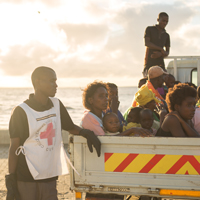
Idai Disaster Update
View the page for this story
Cyclone Idai on March 14 smashed into Beira, a coastal city of 500,000 in Mozambique. The storm, with its twenty-foot storm surge and winds of over 120 miles an hour, left catastrophic destruction in its wake in that locale and brought widespread flooding to the two million or more residents of Mozambique, Malawi, and Zimbabwe. With cholera on the rise in the aftermath, the UN says this is one of the worst natural disasters to ever hit the Southern hemisphere. James Elder, the UNICEF Regional Chief of Communication for Eastern and Southern Africa, joins host Steve Curwood to recount his experiences in Beira after the cyclone and discuss the road to recovery. (08:43)
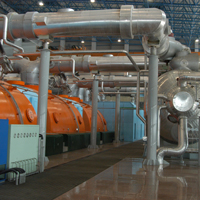
Beyond the Headlines
/ Peter DykstraView the page for this story
This week in beyond the headlines, Peter Dykstra joins host Steve Curwood to discuss China’s step away from nuclear power. In Florida, another energy shift is underway as Florida’s biggest utility makes a switch from natural gas plants to solar power with batteries. Then, in the history vault, the two jump back to 1990 to biologist Sam LaBudde’s heroic undercover operation on a tuna boat that brought to light dolphin deaths caused by the tuna fishing industry. (04:14)
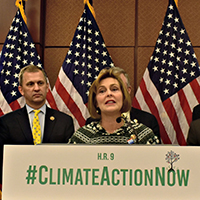
The Power of the Purse and ‘Climate Action Now’
View the page for this story
House Democrats now in the majority have leverage through the federal budget for policies they are keen to advance, including climate action. Their 'Climate Action Now' bill HR 9 would bar President Trump from using federal funds to pull the U.S. out of the Paris Climate Agreement, as he has vowed to do. The bill also calls for President Trump to plan how the U.S. will keep its Paris commitments. Congresswoman Kathy Castor (D-FL), Chair of the Select Committee on the Climate Crisis, spoke with Host Steve Curwood about the prospects of the 'Climate Action Now' bill moving forward. (07:25)

Youth Testify for Climate Action
View the page for this story
Four young people testified at the first hearing of the House Select Committee on the Climate Crisis on April 4, 2019. Chris Suggs, Lindsay Cooper, Aji Piper, and Melody Zhang spoke of their concerns about climate impacts on their generation, especially on low-income and minority groups. The committee members recognized their concerns, though some Republican members argued strong climate action could pose economic risks. (04:16)
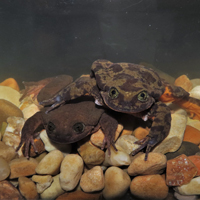
‘Romeo and Juliet’ Frogs’ First Steamy Date
/ Aynsley O'NeillView the page for this story
Sehuencas water frogs, like other amphibians, have been devastated by the chytrid fungus, and a frog that scientists named “Romeo” was the last known of his kind and had stopped singing for a mate. But recently scientists discovered “Juliet” and four other Sehuencas water frogs hiding in the Bolivian cloud forest – and Romeo’s song is back. Sofia Barrón Lavayen, the manager of captive breeding at the K'ayra Center at the Museum of Natural History in Cochabamba, Bolivia, talks with Living on Earth’s Aynsley O’Neill about how the matchmaking is coming along. (06:15)
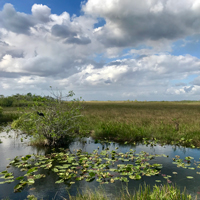
Everglades National Park, a “River of Grass”
/ Lizz MalloyView the page for this story
Established as a national park in 1934 and a UNESCO World Heritage site in 1979, Everglades National Park is much more than a mere swamp. Only an hour’s drive west from bustling Miami, the 1.5 million acres of the Everglades provides a place of sanctuary in nature for those looking for peace and quiet, as well as a front-row-seat view of wildlife from anhingas to alligators. Living on Earth’s Lizz Malloy went to check out the “River of Grass.” (07:33)

Drilling in the Everglades
/ Bobby BascombView the page for this story
The unprotected parts of the Everglades region are open to development, including oil drilling. The Kanter Real Estate group recently won approval to drill an exploratory well in the Everglades ecosystem after a legal battle that started in 2015. Miami Herald Reporter Samantha Gross joins Living on Earth’s Bobby Bascomb to talk about the ruling. (05:44)
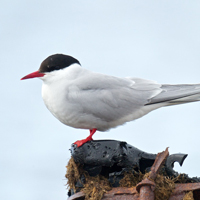
BirdNote®: Rivers of Birds
/ Mary McCannView the page for this story
Along the four major North American flyways, huge “rivers” of Arctic Terns and other migrating birds are now making their way north again. BirdNote®’s Mary McCann describes their incredible journey. (01:46)
Show Credits and Funders
Show Transcript
HOST: Steve Curwood
GUESTS: Kathy Castor, James Elder, Samantha Gross, Sofia Barrón Lavayen
REPORTERS: Bobby Bascomb, Peter Dykstra, Lizz Malloy, Mary McCann, Aynsley O’Neill
[THEME]
CURWOOD: From Public Radio International – this is Living On Earth.
[THEME]
CURWOOD: I’m Steve Curwood.
The Democratic majority in the House has a plan to keep the U.S. in the Paris Climate Agreement: block the president from spending any money to get out.
CASTOR: We just might have a chance to get that provision in an appropriations bill sent to the President. That's where a House majority, House Democratic majority, has a pressure point: through the Appropriations Act, because it is the Congress that has the power of the purse.
CURWOOD: Also, a visit to South Florida and the famous River of Grass.
KOMINOSKI: Why people should appreciate and visit the Everglades is because of its size. It's one of the few large open wilderness areas of the east. It is a place of subtle beauty, that I think many of us have forgotten how to appreciate.
CURWOOD: That and more this week on Living on Earth – Stick Around!
[NEWSBREAK MUSIC: Boards Of Canada “Zoetrope” from “In A Beautiful Place Out In The Country” (Warp Records 2000)]
[THEME]
Idai Disaster Update
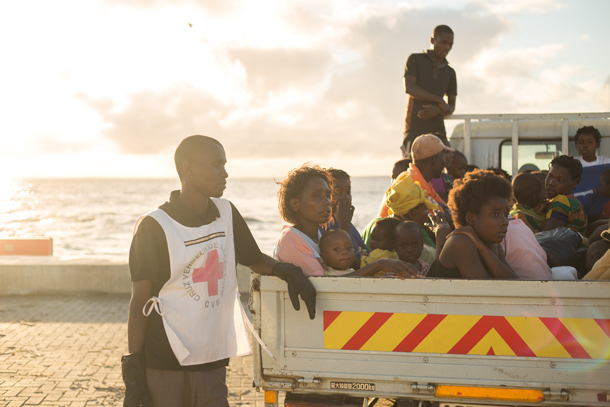
Cyclone Idai is one of the deadliest tropical cyclones in the Southern Hemisphere on record, with over a thousand dead and thousands more still missing and injured. (Photo: Denis Onyodi, Climate Centre, Flickr, CC BY-NC 2.0)
CURWOOD: From PRI and the Jennifer and Ted Stanley Studios at the University of Massachusetts Boston, this is Living on Earth. I’m Steve Curwood.
When Cyclone Idai came ashore March 14th at Beira, Mozambique as a killer category 3 storm it almost completely destroyed that coastal city. The floods and winds also wrecked the homes or crops of two million people in the region that includes Malawi and Zimbabwe as well as Mozambique. And now officials are saying a cholera epidemic is surging, with over a thousand cases already. James Elder is the UNICEF Regional Chief of Communication for Eastern and Southern Africa. He joins us now. James, welcome to Living on Earth.
ELDER: Thank you very much. Good to be here.
CURWOOD: Jim, as I understand it, you've just gotten back from Beira in Mozambique. How was your journey?
ELDER: Um, distressing, in a word. I mean, I've seen more than enough crisis situations, most of them around conflict. Unfortunately, this compared darkly well, to those. I mean even now, weeks after that cyclone, hit and the flooding hit, and you've still got communities with, you know, trees have just been thrown across a major city. Beira is not a small town, power lines are still down, families are still coming to reception centers exhausted, unwell, there are still some communities who are trapped, cattle and livestock are kind of stuck in hard, or they've already drowned. So it's pretty testing scene for people who, let's remember, are pretty used to difficult scenarios, people who are used to adversity and to tackling difficult days. But this really was a double blow. You know, it was a deathly wall of wind, but then also flooding that just never stopped, across an area that had been experiencing poverty and drought.
CURWOOD: I've spent some time in Beira, and in Mozambique. If I recall correctly, Beira's in Sofala Province there, which has had horrific rain storms in the past. A couple of decades ago, I think they had a major problem. To what extent might this compare to their earlier troubles with water?
ELDER: Well, ironically enough, I was there for the floods. Gosh, it must be 12 years ago now, they weren't at this scale, nonetheless, for those people suffering at that time, it was every bit as severe as anywhere else. But the difference here, I think, was as I said, that double blow. The cyclone was devastating, and for whatever climatic reasons, the eye of the storm did hit the city of Beira, thereby decimating homes and, and really picking things up and throwing them as if they were tin cans, whereas in fact, they were houses or trees. And then the flooding, then came seven, eight, nine days, really only the last few days are the first time it hasn't rained. So I think, I mean, the United Nations is referring to this, based on climatic empirical evidence, as, you know, the worst climate disaster in two decades, based on the idea of the amount of water but also, of course, just the sheer force of the cyclone that did so much damage before the flooding came.

In the aftermath of the cyclone, one of the most pressing concerns is the access to clean water and the spread of cholera, typhoid fever, dysentery and malaria. (Photo: Denis Onyodi, Climate Centre, Flickr, CC BY-NC 2.0)
CURWOOD: To what extent are you hearing from folks in the United Nations that this was related to the uptick in very strong storms we see as the planet warms, and that we're likely to see more and more of these stronger storms coming out of the Mozambican channel?
ELDER: Yeah, I think unfortunately, it's fair. It's accurate. I mean, yeah, my place isn't science. But I know enough, even listening to the United Nations Secretary General talking about that, what this means in terms of mitigation and emissions, and remembering that, you know, four-fifths of all emissions are coming out of those G20 rich countries and so on. So the responsibility sits there, but certainly my own anecdotal experience, whether I'm in the north of Nigeria or southernmost tip in Zimbabwe, where we're talking about, you're talking to farmers who lived on the land for three, four, five decades, who are making it very clear that they just can't predict seasons anymore. Things were very predictable and they were their life source that guaranteed the next crop, the next round of food for their families. They can't predict those things. And this is not a generation of people romanticizing a bygone era. This is people who are very clearly reliant on the land and the climate, and they know it extremely well. And they just say now that they, you know, they cannot predict when to plant and how that, how that will go. We are going to continually see this, we're going to see a shortening of space between big storm events, like I'm sure you see in North America. My understanding is, we're just going to see, these are going to be exacerbated, and there's going to be less time in between them, which of course means less time for these people who are already on the margins to actually recover from.
CURWOOD: Let's talk about recovery. And the prospects of these people. You've been to a lot of difficult places over the years, Jim Elder, you've seen things. What are the prospects of recovery for these folks, versus perhaps the need to move, to migrate, and to perhaps become refugees from their homes?
ELDER: So I think these communities are no stranger to hardship. I think, I already saw it. They're just like, if we could just get one or two days without rain, we will rebuild. The international press will perpetually paint them as victims, and rightly so when you get climatic disasters like this, but I, perpetually, when I meet these people and hear their stories, I hear that heroic side. I hear their daily struggle, how people, without comment or whining about it, get on with life and, and find a way to continually take on these great challenges. But in this part of the world, at least for that area of Zimbabwe, in Malawi, in Mozambique, they will get cyclical storms, and cyclical drought. But I don't think these are people who should be having to think about, about migration, but as you're alluding to, you know, in a decade or two, if things continually worsen, then all those things become possible.
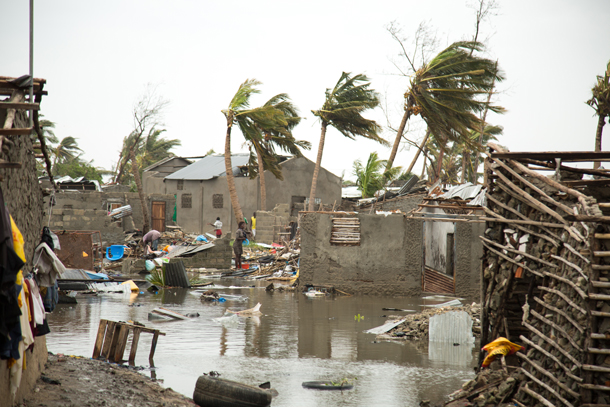
At its peak intensity, Cyclone Idai’s winds were over 120 miles per hour. (Photo: Denis Onyodi, Climate Centre, Flickr, CC BY-NC 2.0)
CURWOOD: You've been to a lot of very difficult places and seen a lot of very difficult things. What, if anything, did you see that surprised you when you went to Beira, Mozambique?
ELDER: Honestly, I think... seven or eight-year-old girl who's lost, lost her entire family and was looking for her family and the way that the community rallied around. A community that had nothing and were sharing whatever they had with her. And were looking to support her in whatever way they could. Now, that's not necessarily something I haven't seen before. But it just surprises me every time. It surprises me in the most positive way, the way that people who've been through hell and lost everything, they still look to someone in the community they don't know at all, but who's part of the community and they will, they will give them that last thing they have. That, I mean, it's not new, but it surprises me every time I see it. That level of selflessness. I mean, I mentioned to the people who are helping her like, you know, how are you finding the capacity to do this? You don't have anything. And what's I guess surprising, is they look at you as if... well, what, what do you mean? What else would we possibly do?
CURWOOD: Before you go, what is the United States doing to help with this calamity in Southern Africa? And what should the US be doing to help?
ELDER: The aid arm of the United States government is always a very big supporter of organizations like my own. UNICEF is, is 100% donor-funded, there's no magic pool of money. So, on one hand, the United States government can be a big supporter in these environments. The World Food Program, and their essential airdrops. But also just moms and dads, their support to UNICEF USA is absolutely critical. At this point, I can't understate that. And I think going forward, it's that. I mean, there's two parts to this. One is it's simply money. Sometimes I feel uncomfortable saying that, but it is, I know that. When we're buying another million vaccines for cholera, or trying to rebuild schools, or even just trying to get people on the ground, so we can repatriate kids that have been separated from families, that costs money, you know. So that money that people can give, be it the government or be it everyday citizens is hugely, hugely valuable. And I guess in terms of what they continue to, beyond funds, is that leadership. Where I live in Eastern and Southern Africa, people continue to look to the States for a kind of leadership. And I think that probably comes to a climatic sense as well. We know that climate change isn't emanating out of those people in Eastern and Southern Africa. They are not part of it. But I think the leadership that comes from people in US, leadership telling the rest of the G20, and the OECD, and the rich world, around the need for reduction in emissions, the need for people to change behaviors, is incredibly important, has an incredibly important impact on the kind of moms and dads and kids who I just so recently saw trying to rebuild through after this disaster in Mozambique.
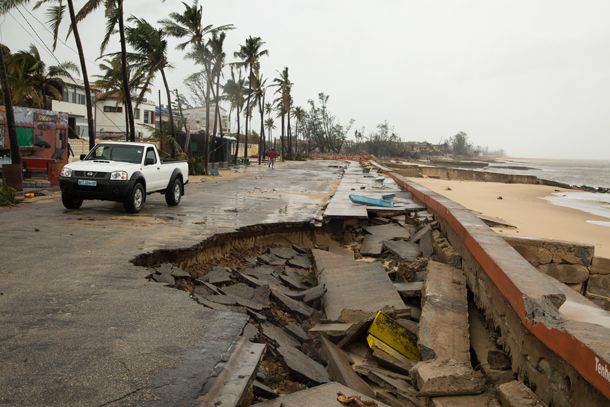
The infrastructural damages from Idai are estimated to cost at least $1 billion. (Photo: Denis Onyodi, Climate Centre, Flickr, CC BY-NC 2.0)
CURWOOD: James Elder is the Regional Communications Chief for UNICEF speaking to us from Nairobi, in East Africa. Thank you so much for taking the time with us today. And we're all grateful for the work you're doing.
ELDER: Thanks so much for the interest in it. Much appreciated.
Related links:
- UNICEF | Cyclone Idai Response
- James Elder’s blog for UNICEF
- CNN | “WHO Steps Up Response As Cyclone Idai Cholera Cases Skyrocket”
- CBC | “Extraordinary Destruction and Flooding in Mozambique Point to Unprecedented Storm”
[MUSIC: Ed Mann & Brian Hand, “Vibes” on Global Warming, Interworld Music]
Beyond the Headlines

Turbine hall of Quinshan Nuclear Power Plant (Photo: IEAE Image Bank, Flickr, CC BY-SA 2.0)
CURWOOD: Now is the time that we take a look beyond the headlines. And our guide is Peter Dykstra. He's an editor with Environmental Health News, that’s ehn.org and daily climate.org. And he's on the line now from Atlanta, Georgia. Hi there, Peter. What do you got for us this week?
DYKSTRA: Hi, Steve. We’re gonna be talking about China, who for the last couple of decades, has been pretty much the strongest booster in the world for building nuclear power plants. They were on a schedule to build 10 to 12 new nuclear plants a year. But new construction seems to have stopped since about the year 2016.
CURWOOD: Oh, what's going on?
DYKSTRA: Well, there are concerns in China as well as elsewhere about not only the cost of nuclear plants, but safety as well. And those two things are intertwined. But some of those safety concerns have actually prompted them to build in more safeguards that are plants that drives the cost of nuclear construction up. All the same time, solar and wind energy has gotten substantially cheaper. China was on a path to build between 10 and 12 new nuclear plants each year, they haven't started a single new one since 2016.
CURWOOD: Hm. Okay, what else do you have for us today?
DYKSTRA: Next up is Florida. And this one also touches on the nuclear industry. The biggest utility in Florida, Florida Power and Light has decided to shut down two of the natural gas plants that it's built. You might remember that there was a big push to switch toward natural gas as what was considered to be a bridge fuel away from dirtier fossil fuels like oil burning and coal burning. As a result, natural gas has been eating coals lunch in the marketplace because it's cheaper. It's also had a big impact on nuclear plan operation and Florida has cancelled the couple nukes as well.
CURWOOD: This is cheaper than nuclear, right?

Solar power matrix (Photo: David Goering, Flikr, CC BY 2.0)
DYKSTRA: It is absolutely cheaper than nuclear. And what Florida Power and Light is going to do in place of these two natural gas plants is build a massive solar battery storage facility, they're already producing a lot of energy from existing solar farms. They want to have a way to store the energy because one of the big criticisms of solar power is that when the sun isn't' out, it's hard to get solar power. It's not reliable. If you have a battery storage facility and that technology is improving all the time, you can fulfill that prophecy by the great temptations of Motown pain, who said, "I've got sunshine on a cloudy day..." and thank me for not singing it.
CURWOOD: Thank you, Peter. By the way, how big is this battery array? I mean, to store grid scale electricity. I mean...
DYKSTRA: Florida Power and Light says that this new facility will be the biggest in the world by a factor of four over the previous champion, a solar battery storage project in Australia.
CURWOOD: Wow. It's time now to walk over to the history evolved and peek inside and what do you see?

Sam LaBudde, 1991 Goldman Prize recipient (Photo: Goldman Environmental Prize)
DYKSTRA: Turn the clock back 29 years, the year 1990. This time of year early April Starkist made an earth-shattering announcement was going to end the practice of buying tuna that had been caught in purse seine nets. Those nets would close in an entire school of tuna. Dolphin often swam in association with tuna. They trap and kill a lot of dolphins while in search of tuna. It was causing a huge problem with dolphin populations. What prompted Starkist to make this announcement was a couple years earlier in 1988, there was an activist named Sam LaBudde buddy who went undercover. He crewed on the tuna boat as a cook and took video with a fishing operations. The video of dolphins dying and tuna nets really shocked the world, brought the problem of dolphins dying for tuna to great public light. And Hines who owns the Starkist brand became the first to ban the purchase of purse seine tuna. The other companies followed suit. And Sam, nobody was one of the first winners of the Goldman Environmental Prize.
CURWOOD: Thanks, Peter, Peter doctors and an editor with Environmental Health News at ehn.org and daily climate.org. And we'll talk again real soon.
DYKSTRA: All right, Steve, thanks a lot. Talk to you soon.
CURWOOD: And there's more on these stories at our website, loe.org.
Related links:
- MIT Technology Review | "China’s losing its taste for nuclear power. That’s bad news."
- Ars Technica | "Florida utility to close natural gas plants, build massive solar-powered battery"
- Friends of the Earth | Save the dolphins: the 40 year battle is renewed
[The Temptations, "My Girl" on The Temptations Sing Smokey, Motown Records]
CURWOOD: Coming up – Romeo and Juliet are two endangered frogs who may just help save an entire species.
ANNOUNCER: Support for Living on Earth comes from Sailors for the Sea and Oceana. Helping boaters race clean, sail green and protect the seas they love. More information at sailors for the sea dot org.
[CUTAWAY MUSIC: Ed Mann & Brian Hand, “Friendly Jungle” on Global Warming, Interworld Music]
The Power of the Purse and ‘Climate Action Now’

Congresswoman Kathy Castor (D-FL) introduced HR 9, Climate Action Now, on March 27, 2019. (Photo: House Select Committee on the Climate Crisis)
CURWOOD: It’s Living on Earth, I’m Steve Curwood. World leaders finally agreed on a climate action plan in Paris back in 2015, but as soon as President Trump took office in 2017 he declared the US would back out at the earliest possible moment in 2020. While federal climate action has been stalled, nonetheless many states, cities and private businesses have taken up the challenge. And now the new Democratic majority in the House of Representatives is trying to legislate to keep the US in the Paris Climate Agreement. The House is powerful when it comes to government finance and Congresswoman Kathy Castor, a Florida Democrat and Chair of the Select Committee on the Climate Crisis, recently introduced the “Climate Action Now Act” that would ensure the U.S. meets its Paris goals. Representative Castor joins me now from Tampa, Florida. Welcome back to Living on Earth!
CASTOR: Well, thank you so much.
CURWOOD: So tell me about the Climate Action Now Act that you recently introduced, what are the key points in this act?
CASTOR: Well, the Democrats, who now are in the majority in the House of Representatives, are delivering on our promise to take bold action to confront the climate crisis, which is heaping huge costs on families and businesses. And unfortunately, the Trump administration, President Trump, said, we're going to leave the Paris Climate Agreement. So our H.R. 9, Climate Action Now bill, would say that we intend to stay. We're not going to retreat, we're not going to cut and run, we are going to live up to our commitments. It also requires the president to come up with a plan for how he is going to meet our commitments. When we entered into this agreement with the rest of the world, we said we will develop a plan to reduce carbon pollution by 26 to 28% beyond 2005 levels, and we will aim to do that by 2025. The Obama administration was on track to do that through the Clean Power Plan, developed after years of working with stakeholders and states, and working people across America. And we've lost momentum under the Trump administration, we have got to get back on track.
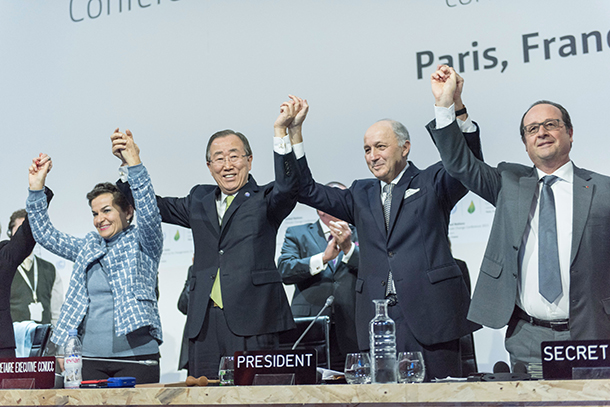
The leaders of the Paris Agreement celebrated its adoption at COP21 in December 2015. From left: Executive Secretary of the UN Framework Convention on Climate Change (UNFCCC) Christiana Figueres; Secretary-General Ban Ki-moon; President of COP21 Laurent Fabius; and French President François Hollande. (Photo: CC BY-NC-ND 2.0)
CURWOOD: Why is it important to introduce the Climate Action Act right now?
CASTOR: It's vitally important, we don't really have a choice. The problem is that time is of the essence here. The impacts and costs of the climate crisis are escalating. You open the newspaper, you turn on the radio every day, you hear about a new climate-driven catastrophe. And we simply have got to reduce the greenhouse gases and begin -- continue this transition but do it in a bolder fashion.
CURWOOD: Now, part three of your bill says and I quote here -- "notwithstanding any other provision of law, no funds are authorized to be appropriated, obligated or expended to take any action to advance the withdrawal of the United States from the Paris Agreement." So whether or not your entire bill passes, might this appear as an amendment to some broad appropriations measures?
CASTOR: You bet. That's where a House majority, House Democratic majority, has a pressure point, through the Appropriations Act, because it is the Congress that has the power of the purse. I would not be surprised if this is contained in the appropriations bills that pass the House of Representatives. And hopefully there are enough Republicans and Democratic members in the US Senate that will go along with that. For example, new Senator Mitt Romney from Utah has stated clearly that he believes that the Paris Climate Agreement is not only about climate, it's about America remaining a global leader. He's not alone. When you look at the polls across the country, most Republicans support staying in the Paris Climate Agreement. And I think with that momentum, we just might have a chance to get that provision in an appropriations bill sent to the President.

Speaker Pelosi spoke on March 27 at the introduction of Climate Action Now. (Photo: House Speaker’s Office / Facebook)
CURWOOD: How tough might you have to be, might you have to attach this to something that must pass -- a defense appropriation, something that the vast majority of the Republican caucus in the Senate would be in favor of?
CASTOR: I can tell you've watched the Congress! [LAUGHS] You know how, how things work, sometimes. Yes, we will use every tool at our disposal. Like I said, we simply don't have a choice. The longer the United States at the federal level does not take bold action, the more costly it's going to be in coming years. We're behind already, based on the Fourth National Climate Assessment that the Trump administration released last November, we know that climate change is happening from faster than we anticipated. For a little while it looked like we were doing better here on greenhouse gas emissions; but no, reports say they are increasing at extreme levels. Same with methane, there was another report out this week. So time is of the essence.
CURWOOD: Representative Castor, when might your bill come up for a vote in the House, when will you get through the hearings process and bring it out to the floor, do you think.
CASTOR: The Climate Action Now Act, H.R. 9 is referred to two committees: The Foreign Affairs Committee, led by Elliot Engel of New York, and the Energy and Commerce Committee, led by Frank Pallone from New Jersey. We are going through regular order in the House of Representatives now, so the committees will have an opportunity to weigh in -- possibly amend the act, but it's pretty straightforward. Then I anticipate it will come to the floor of the House for a vote in April. And I hope it will be a strong bipartisan vote. This is something we can agree on. And Republicans in the House have sponsored similar resolutions. So we're going to be pushing for a big bipartisan vote on H.R. 9, Climate Action Now.

Rep. Kathy Castor (D-FL) is a seventh-term Congresswoman and Chair of the House Select Committee on the Climate Crisis. (Photo: United States Government, Wikimedia Commons, Public Domain)
CURWOOD: So the 195, 197 other nations that signed on to Paris were well aware of the American election cycle and set this date as November 4th of 2020 that the US could, at the very earliest, be legally out of the Paris deal. But the time to give the notice is November of this year, to say, Okay, now we're going to proceed. How much do you think this is an issue for the upcoming presidential election?
CASTOR: It is interesting, isn't it that the US cannot withdraw until November 2020, right at the time of the presidential election. I think that guarantees that climate change will be on the minds of folks as they go into the voting booth. And you've seen it already, in the, from the whole host of Democratic candidates who have announced, with some, like Governor Jay Inslee of Washington, who's made it his flagship issue, his number one issue. And I think families and businesses across this country can be heartened by that. Also by the activism of the generation that is going to bear the burden and carry the load for the consequences of the changing climate.
CURWOOD: Congresswoman Kathy Castor represents Florida's 14th district and is Chair of the Select Committee on the Climate Crisis in the House. Congresswoman, thanks so much for taking the time with us.
CASTOR: Thank you very much.
Related links:
- Website for the House Select Committee on the Climate Crisis
- HR 9, the Climate Action Now bill
- Watch: Speaker Nancy Pelosi and Select Committee Chair Kathy Castor introduce HR 9
- The Atlantic | “On Climate, Democrats Now Have a Plan to Make a Plan”
Youth Testify for Climate Action
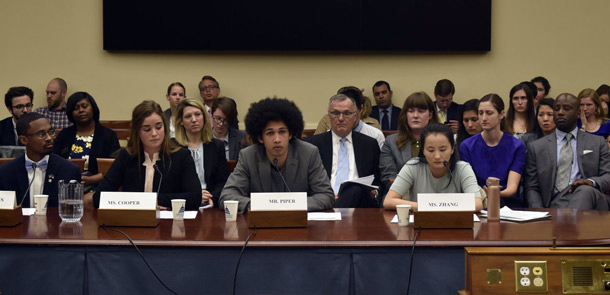
Juliana youth plaintiff Aji Piper, center, testifies before the House Select Committee on the Climate Crisis on April 4, 2019. (Photo: House Select Committee on the Climate Crisis)
CURWOOD: By the way, Representative Castor says the House Select Committee on the Climate Crisis plans to hold a series of hearings across the country. Its first hearing invited young people to Capitol Hill on April 4th. 18-year-old Aji Piper of Seattle is one of the plaintiffs in the Juliana suit that demands the government recognize the right to a livable climate in the years to come.
PIPER: It is the constitutional duty of the government to protect public trust resources on which we all depend, and to protect us from any damages it may inflict upon its citizens. Instead, the government is taking actions that are directly contributing to destruction of our planet. It is actively abusing the trust of its most vulnerable citizens – the youth.
CURWOOD: Melody Zhang of the Christian social justice group “Sojourners” invoked her faith as her inspiration for climate action.
ZHANG: As a Christian, I believe God calls us to a total and radical re-imagination and transformation of our relationship with others and the earth. As political leaders, especially ones of faith, I implore you to respond faithfully and with full force to love God and neighbor by enacting just, compassionate and transformative climate policies which rise to the challenge of the climate crisis.
CURWOOD: Lindsay Cooper of the Louisiana Governor’s Office of Coastal Activities said her family had to relocate after Hurricane Katrina, and many of her friends never moved back.
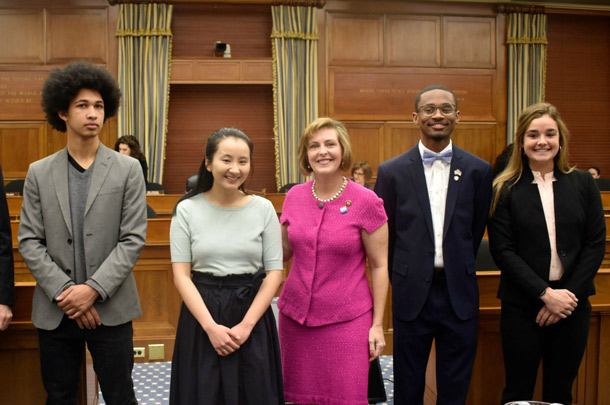
From left: Aji Piper, Melody Zhang, Congresswoman Kathy Castor, Chris Suggs, and Lindsay Cooper. (Photo: Rep. Kathy Castor’s Office)
COOPER: Some call us a canary in the coal mine or harbingers of bad things soon to happen around us. We have already lost 2,000 square miles of coastline since the 1930s and stand to lose much more in the years to come without significant action. To others, we are a living laboratory, a testing ground for new opportunities, and a place where community needs, cutting edge science, effective natural and manmade infrastructure, and good public policy can come together to balance the interests of economy and environment.
CURWOOD: Republican Congresswoman Carol Miller, a climate committee member from West Virginia, spoke out against regulations designed to limit global warming gas emissions.
MILLER: I’ve seen the devastation that a top-down one size fits all government approach can cause. We saw this with the war on coal from Obama administration. The decimation of the coal industry in my state ravished our economy, particularly in the southern part of the state.
CURWOOD: As the hearing was winding down, Republican Congressman Gary Palmer of Alabama spoke up and then was challenged by California Democrat Jared Huffman and Chairwoman Castor.
PALMER: I want to ask unanimous consent to enter a couple things into the record - one is the IPCC's climate change fiscal science basis and just want to point out, what they found in this report - there's no robust trends in annual numbers, tropical storms, major hurricanes counts that have been identified over last 100 years in north Atlantic basin.
"Our Government has consciously sanctioned climate destruction...for more than five decades." -Aji Piper @climatecrisis #climateactionnow #youthvgov pic.twitter.com/b1g8gHUUSz
— Our Children's Trust (@youthvgov) April 4, 2019
HUFFMAN: And Madam Chair, just for clarification, we're entering the entire reports into the record, right? Not select schedules that may tell partial stories. I mean I certainly wouldn't want any misleading partial sections, I wouldn't want Bob Barr redacting it, I'd like to see the whole report! [LAUGHTER]
CASTOR: Without objection those are entered into the record. I'd also like to note, I did have an opportunity to glance at Mr. Palmer's request here and while it talks about the trends in the number of tropical storms, hurricanes, major hurricane counts - I can tell you as a Floridian that's lived through the past few years – that yes, the number may not be impacted, but the intensity, the size, the amount of moisture in the atmosphere when you're talking about flooding - those are at issue. And those are going to be some of the issues we'll address here going fwd.
CURWOOD: The House Select Committee on the Climate Crisis plans to continue holding bipartisan hearings under the leadership of Democrat Kathy Castor. Senate Democrats formed their own “Special Committee on the Climate Crisis" on March 27th after Republican Majority Leader Mitch McConnell refused to establish a bipartisan Senate climate crisis committee.
Related links:
- More about the young people who testified at the hearing
- Watch the April 4, 2019 House Select Committee on the Climate Crisis “Generation Climate” hearing
[MUSIC: 2Cellos, “Cinema Paradiso” on Score, by Ennio Morricone/Andrea Morricone, Portrait/Sony Music Entertainment]
‘Romeo and Juliet’ Frogs’ First Steamy Date
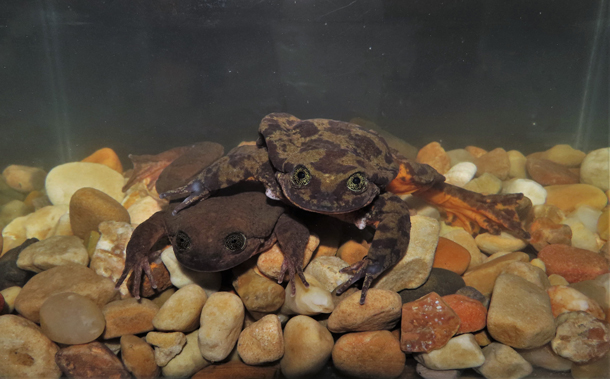
Romeo and Juliet. This match gives hope to a species that was on the brink of extinction due to destruction of its habitat and the deadly disease chytrid fungus. (Photo: Courtesy of the K’ayra Center for Research)
CURWOOD: The deadly chytrid fungus is responsible for dramatic declines in more than 500 species of frogs and other amphibians, according to recent study published in Science. And as many as 20% of those amphibians now are assumed to be extinct. Until recently, sehuencas water frogs were among those on the brink of extinction. Just one male, named Romeo, was living in a lab in Bolivia, assumed to be the last of his species. But researchers recently found 5 more of these frogs in a cloud forest in the mountains of Bolivia. They took one of the females, named her Juliet, and brought her to meet Romeo. Hoping they won’t be star-crossed lovers, the researchers are now breeding Romeo and Juliet in an attempt to save the species. Sofia Barrón Lavayen is the head of conservation breeding for the K’ayra Center at the natural history museum in Cochabamba, Bolivia. She spoke with Living on Earth’s Aynsley O’Neill about how the matchmaking is coming along.
O’NEILL: Tell us a little bit of the backstory. How did Romeo and Juliet meet?
BARRÓN: First, Romeo was in Center K'ayra since 2009. So that means ten years he was alone, and we thought he was the last species. So we created this project to go to look for a mate. That's how we found Juliet on December 2018. And that's how they are together now.
O’NEILL: And so they had their first date. How do you set up the first date for a frog? Is there mood music, are there low lights?
BARRÓN: Yeah, first it's really important for amphibians that the water quality has to be perfect. All the parameters has to be perfect for the species. Why? Because exactly this species, Sehuencas water frog, is an aquatic frog. So they breathe and exchange all the ions through the skin, so that's why the water is so important. So first we need to check that the water has to be perfect and then the temperature as well. And then it's really interesting because all amphibians around the world, they reproduce, they know that it's breeding season because of the rain. So we install like a rain system in the water that helps to, helps to realize for the frogs to be in the breeding season. So first we did all these things, we prepare, and then we put it together. The day was really amazing for me, was super exciting. All the team was really excited, because when we put Romeo together with Juliet, we record the first call. So Romeo called for the first time with a mate.
[SEHUENCAS CALL]
The last call we recorded was in 2017, so two years ago, but now we register the this call. They are looking for a mate. So it's the courtship call. It was really amazing. It's super loud and it's the first record for this species.
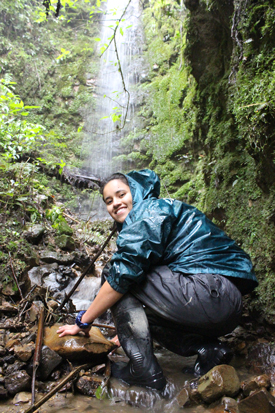
Sofia Barrón Lavayen during the expedition when Juliet was discovered, along with four other Sehuencan water frogs. (Photo: Courtesy of the K’ayra Center for Research)
O’NEILL: I'm glad to hear that the date was going well. And since the first-time Romeo has been with another of his species in such a long time in 10 years, how was he acting on the date? Was he romantic? Was he nervous?
BARRÓN: Yeah, he looked a little bit nervous in the beginning, but then he looked at Juliet and he swam directly to her to do the amplexus. Amplexus is the mating embrace position for frogs. He swam really fast into her, and he started doing also a really funny dance we called twinkly toes. He moved his toes, like in a dance dance, like he was shaking his toes while he was in amplexus. So that was also something new for us. So he was a little bit shy and then he directly went with Juliet, so he was super happy and Juliet as well.
O’NEILL: What is your favorite part about taking care of these frogs?
BARRÓN: For me it's really funny to give them food because their behavior is really fascinating. The frogs catch the worms with their front legs, making a forward movement, and sometimes the worms escape or the frogs cannot catch. It's like, a little bit silly for me because they don't catch it immediately, super funny to watch. But when Romeo was alone in the aquarium he ate immediately the worm of the isopod. But now since Juliet is with him, he leaves the worms and the isopods for her. It's really interesting. That's also new for us. We've never seen it before. So it's something interesting.
O’NEILL: And how of Romeo and Juliet been in the days after their first date?
BARRÓN: Well, they were trying amplexus a lot of times. The longest amplexus was 15 minutes. I hope they are gonna lay eggs soon. I'm really excited to see the eggs, because we don't know how many eggs they put. We don't know where they put it, where they lay the eggs under the rocks, or between rocks, or just in the surface of the aquarium. We don't know, it's something new for us. We are also really excited to see it.
O’NEILL: What would happen if Romeo and Juliet don't get along romantically?
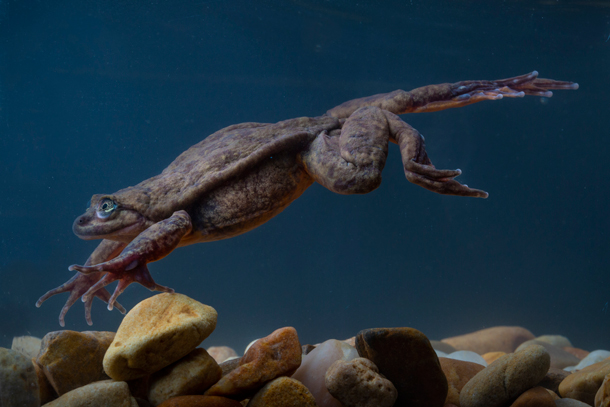
Juliet has proven to be healthy and outgoing. Researchers are hopeful that she and Romeo will be able to reproduce. (Photo: Robyn Moore, Global Wildlife Conservation)
BARRÓN: Oh, we have a lot of options. Juliet and Romeo are not the only individuals of these species. We have four more individuals. That means two more couples. So our option B is to try with the other couples, mix Romeo with the other frog, with the other two females. Or the other male, mix with Juliet and yeah, we have a lot of options. Yeah, I'm really happy for the conservation of this species, I'm pretty sure they are going to reproduce.
O’NEILL: Sophia, thank you so much for taking the time.
BARRÓN: Oh, thank you everybody and keep in touch for the news from Romeo and Juliet.
Related links:
- Museo de Historia Natural Alcide d’Orbigny | “Romeo & Julieta - (La Primera Cita)”
- Global Wildlife Conservation | "A Q&A With Romeo & Juliet’s Personal Assistant"
- Global Wildlife Conservation | "#Match4Romeo"
- National Geographic | "Meet Romeo, 'world’s loneliest frog,' and his new mate Juliet"
- New York Times | "Romeo, Meet Juliet. Now Go Save Your Species."
[MUSIC: Marvin Gaye, “Let’s Get It On”, Motown Records, Tamia]
CURWOOD: Your comments on our program are always welcome. Call our listener line anytime at 617-287-4121. That's 617-287-4121. Our e-mail address is comments at loe dot org. - comments at loe dot org. And visit our web page at loe dot org. That's loe dot org.
CURWOOD: Coming up – A controversial plan to drill for oil in the Everglades. That’s just ahead on Living on Earth.
ANNOUNCER: Funding for Living on Earth comes from you, our listeners, and United Technologies, combining passion for science with engineering to create solutions designed for sustainability in aerospace, building industries, and food refrigeration. UTC companies such as Otis, Carrier, Pratt and Whitney, and UTC Aerospace systems are helping to move the world forward. You can learn more about United Technologies by tuning into the Race to Nine Billion podcast; listen at racetoninebillion.com. This is PRI, Public Radio International.
[CUTAWAY MUSIC: Louis Jordan & his Tympany five, “A Man Ain’t a Man” on Louis Jordan & his Tympany five, Soul Vibes]
Everglades National Park, a “River of Grass”
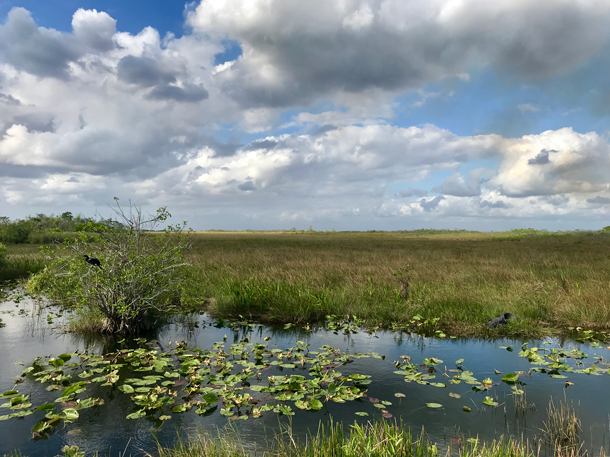
The Everglades National Park provides visitors with a variety of beautiful vistas. (Photo: Lizz Malloy)
CURWOOD: It’s Living on Earth, I’m Steve Curwood.
The Everglades National Park in Florida is the third largest National Park in the lower 48 states and contains 1.5 million acres of protected wilderness. And UNESCO names it a world heritage site that’s in danger. The Everglades is often called the river of grass for its vast system of slow moving bodies of water which spread much further than the National Park boundaries. Over the years attempts to fill in and drain these wetlands to build homes and farms have damaged and polluted the Everglades. And, despite conservation efforts, today the Everglades is only about half its original size. Living on Earth’s Lizz Malloy went to visit Everglades National Park.
[MUSIC: Afro Cuban All Stars, “Amor Verdadero” on A Toda Cuba Le Gusta, World Circuit]
MALLOY: Miami, Florida. It brings some immediate images to mind, often involving beaches, parties, and glamour. From the tourist packed Ocean Drive, the bustling streets of Brickell, to the music filled air of Calle Ocho in Little Havana. Even if you are on vacation, in Miami it seems like there is no time to relax.
[MUSIC: Afro Cuban All Stars, “Amor Verdadero” on A Toda Cuba Le Gusta, World Circuit]
MALLOY: Many looking for a bit of peace and quiet from the never-ending party that is South Beach head south towards the keys.
[DRIVING SOUNDS]
MALLOY: But, there is a sanctuary just an hour west of Miami. The vast and peaceful wilderness of Everglades National Park.
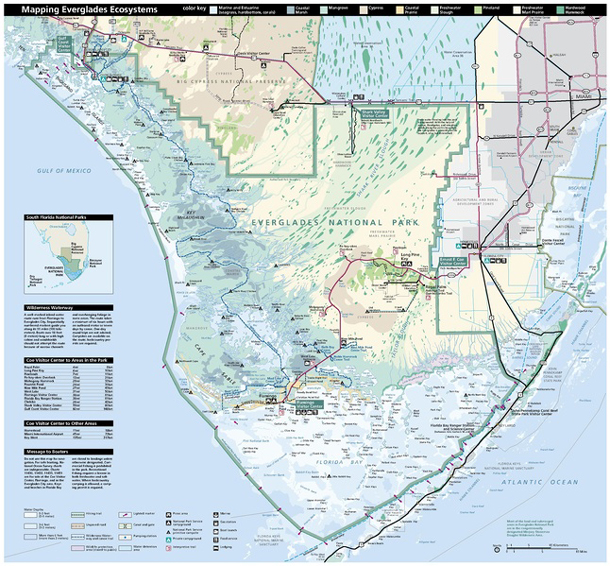
The Everglades National Park is only a portion of the natural ecological system that is the Everglades. (Photo: National Park Service, Wikimedia Commons CC)
[DRIVING SOUNDS]
MALLOY: As I drive west towards the national park the electricity of Miami dwindles and the skyscrapers fade away. The air softens as the sounds emerging from the open windows change from beeping horns to birds.
[BIRD SOUNDS]
MALLOY: There is a visitor center not too far into the park where I am going to meet my guide who will introduce me to many of the exciting species of the everglades.
KOMINOSKI: My name is John Kominoski and I'm an associate professor at Florida International University in Miami. I'm an ecosystem ecologist and I've been studying the Everglades for the past seven to eight years.
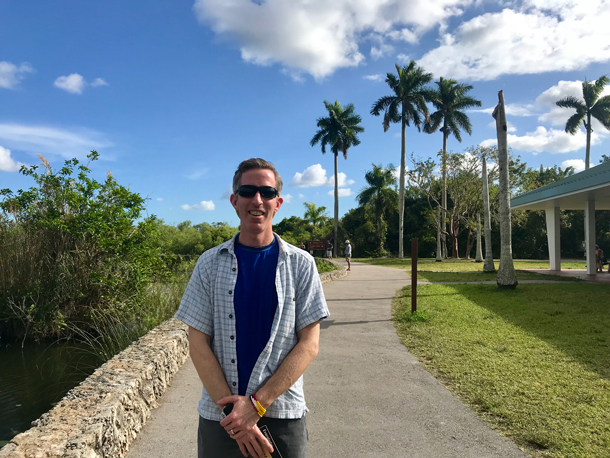
John Kominoski is an Associate Professor and ecosystem ecologist in the Department of Biological Sciences at Florida International University in Miami. His research focuses on organic matter processing at the interface of terrestrial and aquatic ecosystems and is part of the Florida Coastal Everglades Long Term Ecological Research. (Photo: Lizz Malloy)
MALLOY: John sports an excited smile and long khaki pants, despite the 82-degree weather. He describes the Everglades as a mosaic of habitats and that nothing like it can be found anywhere else in North America. Soon we embark on a journey to one of John’s recommended trails. Dense carpets of grasses extend toward the sky on either side of the road.
KOMINOSKI: It looks like a prairie. It doesn't look like a typical wetland that people are familiar with. When you're on the ground, you can't really see these open water habitats. And you would probably assume that the whole area was dry.
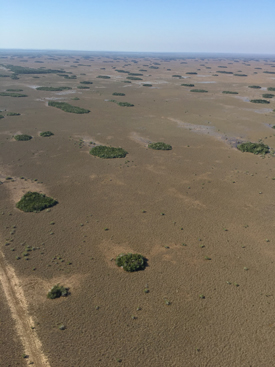
The Everglades is spotted with tear drop shaped tree islands. (Photo: John Kominoski)
MALLOY: From the mid 1800’s to the mid 1900’s there were constant efforts to develop the Everglades because it was seen as useless land. It wasn’t until Marjory Stoneman Douglas wrote The Everglades: River of Grass in 1947 that people began to recognize the Everglades as the rare ecological jewel that it is.
[BIRD AND WALKING SOUNDS]
KOMINOSKI: Okay! So, here we are at Royal Palm. Also known as Anhinga Trail and Gumbo Limbo Trail.
MALLOY: John heads through the trail entrance past massive banyan trees enveloped by strangler figs that look like they are made of dripping wax.
[WALKING SOUNDS]
KOMINOSKI: There's always water here because it's a canal essentially. So this is a great place for people to come to see alligators to see fish and hear fish, and birds and frogs and all that. So, we've got the double crested cormorant that's resting there on that dead branch. And we've got -- red, the red bark tree is gumbo limbo, as in the gumbo limbo trail. It's also called the tourists tree because it's red and peel-y [LAUGHS].
MALLOY: Along the other side of the trail is a sea of grasses that extends towards the sky, meshing greens, golds, and blues. Speckling the sawgrasses and invasive cattails are a variety of birds that don't seem to mind our company.
[BIRD SOUNDS]
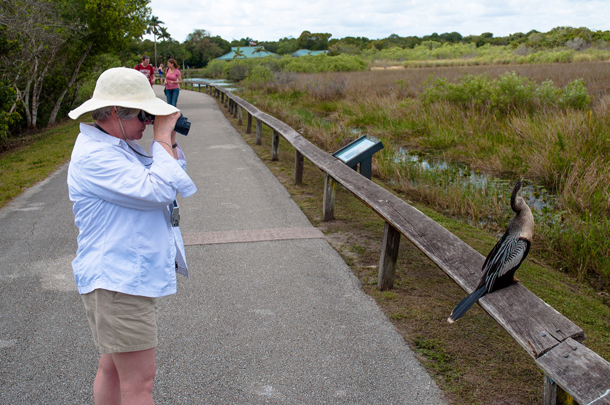
The native Anhinga is not easily bothered by tourists in the park. (Photo: alans1948, Flickr CC BY 2.0)
MALLOY: A native diving bird called the anhinga suns its wings on a railing as a group of visitors look on and angle for photos. Unlike other water birds, such as ducks, anhingas don't have oil on their feathers to keep them dry when dive in the water for their prey. This helps them weigh their bodies down so they can dive deeper, but to dry off it takes a little bit of time and some sunbathing.
KOMINOSKI: Should we walk down to the end of the trail…?
MALLOY: Yeah!
MALLOY: This trail is full of excited visitors pointing and smiling at all the different wildlife that surrounds them.
KOMINOSKI: Okay, so here's our first alligator and whoa! Active!
MALLOY: An alligator, some 6 feet long, jumps in the canal about five feet in front of us behind the trail railing and scoops up a baby alligator in its mouth like a snack.
KOMINOSKI: So, this is definitely a female. And, it's possible that that jump that she made was to protect her baby. Wow. That is really special.
[ALLIGATOR CHIRPS]
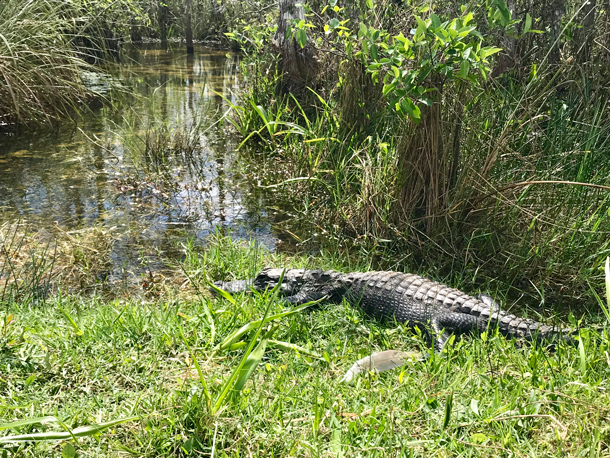
The American Alligator is an abundant species in the Everglades. (Photo: Lizz Malloy)
KOMINOSKI: Yeah, she's definitely protecting that little one. Beautiful. This is kind of one of the beautiful, unique experiences you get when you're out in the Everglades.
MALLOY: Female alligators are protective mothers, who will sometimes keep their babies in their mouths to protect them from predators, like other alligators or even some birds. When they hear their babies making their distress call…
[ALLIGATOR CHIRPS]
MALLOY: ... the mother alligators go into full defense mode. But, I suppose that we aren't much of a threat because soon she lets her baby swim free from her jaws.
KOMINOSKI: This is the only place in the world where crocodiles and alligators coexist. And, fun fact, the American crocodile is very docile and actually more docile than the American alligator. So the American alligator is more territorial than the American crocodile, but the crocodile look scarier than the alligator to me.
MALLOY: I was inspired by John’s descriptions of the mangroves and megafauna that lie where the Everglades meets the ocean. So, I began my 30-minute drive south to the Flamingo visitor center. Grasslands became cyprus domes and cyprus domes became hardwood hammocks and hardwood hammocks eventually became mangroves as I reached my destination.
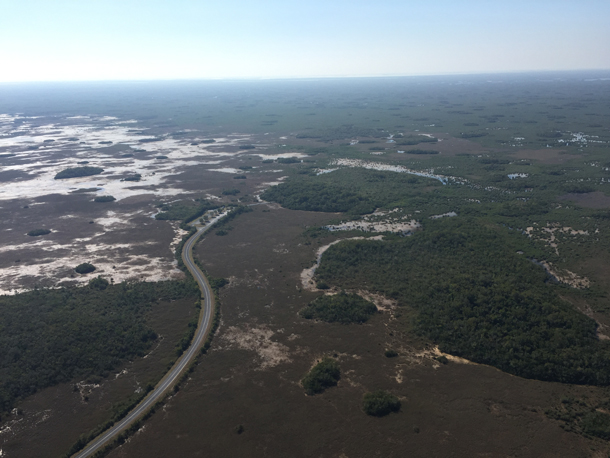
A scenic road connects Ernest Coe Visitor Center and Flamingo Visitor Center in the Everglades National Park. (Photo: John Kominoski)
MALLOY: I rent a kayak at the visitor center.
[WATER SOUNDS]
MALLOY: And paddle through the waters that are the lifeblood of the Everglades. Thrilled to be drifting past lumbering manatees and sun-bathing crocodiles. I feel like the star of my own nature documentary.
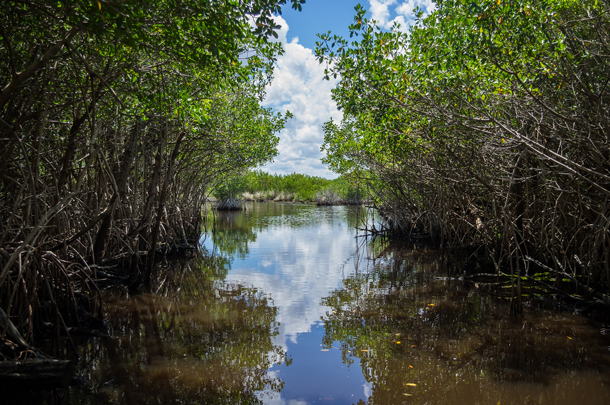
Where Everglades National Park meets the ocean, visitors can kayak through the mangroves. (Photo: Vincent Lammin, Flickr CC BY-NC-ND 2.0)
[WATER SOUNDS]
MALLOY: I can easily see why my guide John Kominoski loves this national park.
KOMINOSKI: You don't have to be a scientist to appreciate and want to protect the everglades. I think you just have to be somebody that wants to connect with yourself and with nature in a place that is experiencing a lot of change and may not be here for as much time as we hope it will be.
MALLOY: And change here means sea level rise, development, and climate change, which all threaten this delicate ecosystem. But, drifting along with the manatees, all that seems a million miles away.
[BIRD SOUNDS]
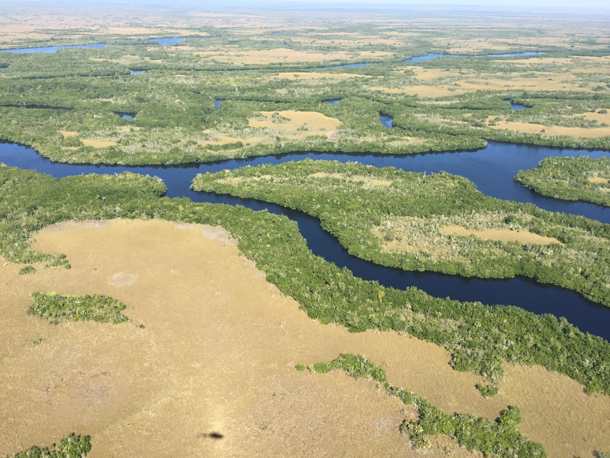
The Everglades National Park, although only half of its original size, covers 1.5 million acres. (Photo: John Kominoski)
MALLOY: For Living on Earth, I’m Lizz Malloy in the Everglades National Park.
[BIRD SOUNDS]
Related links:
- More information about the Everglades
- Everglades National Park
- About Marjory Stoneman Douglas, author of "River of Grass"
Drilling in the Everglades
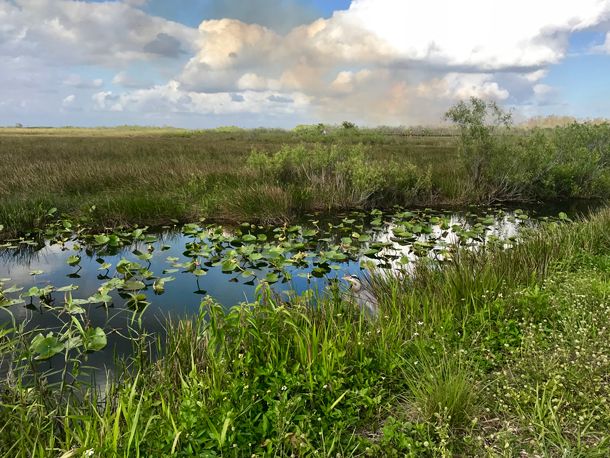
The Everglades ecosystem is comprised of a variety of vegetation, such as sawgrass, that coats the expansive waterways that lie underneath. (Photo: Lizz Malloy)
CURWOOD: After years of legal wrangling a South Florida family recently won the right to drill for oil in a part of the Everglades outside the National Park. Samantha Gross is with the Miami Herald and has been following the case and she spoke to Living on Earth’s Bobby Bascomb.
BASCOMB: Now when I first read this headline "Florida Family Wins the Right to Drill for Oil in the Everglades." I thought it was a joke. Maybe an article from the satirical newspaper The Onion.
GROSS: No, it's a real case that's been about four years of legal battle for this family who mainly is made its fortune in real estate to have granted permission to drill and exploratory well for oil in the Everglades, just west of the Broward County suburbs near Miramar.
BASCOMB: So, this piece of land is owned by the Kanter family. They own about 20,000 acres in the Everglades. But this isn't actually the Everglades National Park. Can you tell me about this piece of land and where it sits in relation to the park and the whole system?
GROSS: Yeah, so this piece of land and specifically the piece that they want to drill on is part of this 20-mile-wide, hundred 50-mile-long stretch of shale that basically stretches between Miami and Fort Myers. It's called the Sunniland Trend and that western part of the stretch has been tapped for oil before, but the eastern part has not been tapped yet. And so the Kanter family wants to find potential for oil there. This eastern part of the land sits basically in one of the three conservation areas of the South Florida Water Management District, and it's just west of the Broward County suburbs. It's quite close to residential South Florida.
BASCOMB: But it's still technically the Everglades?
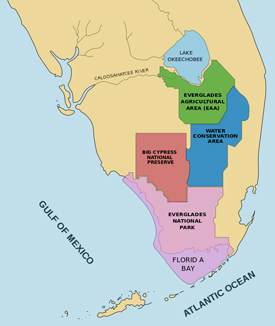
The Everglades is composed of much more than the national park. The Everglades reaches up through national preserves and conservation areas all the way up to Lake Okeechobee. (Photo: Wikimedia Commons CC)
GROSS: Yes.
BASCOMB: Now, from what I understand the Florida Department of Environmental Protection and the local municipalities are opposed to the Kanter families plan to drill in the Everglades. But the First District Court of Appeal ruled against them. Tell me what happened there?
GROSS: Yeah. So the First District Court of Appeal did rule against them. From the folks that I spoke with DEP didn't have the right expert testimony. There were some things that I guess, you know, weren't as convincing as it could have been. But, Noah Valenstein, who's the DEP secretary, who was recently re-appointed, said that, you know, DEP hasn't changed its long-standing policy to deny oil and gas permits. And it's something that they, you know, we're going to continue to fight but, it's unlikely the agency is gonna to take it to Supreme Court, some attorneys have told me. So, the DEP put out a statement actually saying it's reviewing options and it wants to help Broward County and the cities in that area fight this plan. So the Department of Environmental Protection has come out saying that they're disappointed but that they're gonna to continue to review their options and work with Broward County and do what they can so.
BASCOMB: So, despite winning the permit to drill for oil and the Everglades, the Kanter family needs zoning approval from Broward County for them to move forward with this project. How likely are they to get that do you think?

Oil rigs in Big Cypress National Preserve have been active since 1943. (Photo: Wikimedia Commons CC)
GROSS: I feel like it's definitely going to be a fight. Broward County has come out and said that they don't support this plan. When the first District Court of Appeal announced this decision in favor, there was a request by the state of Florida, Broward County, and the city of Miramar to rehear the case, which was denied eventually. But, I mean, there's intense opposite in Broward County.
BASCOMB: Now the family they want to drill an exploratory well on five of their 20,000 acres. What will that entail?
GROSS: So, an exploratory oil well basically is just a well operation to see the potential for oil, not necessarily to extract oil. People have said that, if discovered, that well could produce about 180,000 to 10 million barrels at the very most and it would probably be priced at about $50 per barrel. You know, environmentalist say that oil that is extracted from the Florida shale isn't clean oil, it's not part of Florida's economy. It's not something that the state profited off of in the past.
BASCOMB: And, the family argued that the land that they want to explore for oil is already degraded, that this isn't pristine wilderness. So it's not a big deal. How true is that do you think?
GROSS: So, people that I spoke with including this one environmentalist comes to mind, his name's Matthew shorts, and he is the executive director of the South Florida Wildlands Association. He said that that whole argument that the land is environmentally degraded is ludicrous. And he, he kind of pointed out an interesting point, which is that in South Florida, specifically, limestone, which makes up major part of that land, is not going to isolate anything. It's not degraded land, it's extremely porous. And any sort of operation like this would really affect that piece of land just because if there's a washed over oil pad and rain comes through water is going to distribute that all over because the land is so porous, and it's so sensitive to anything really.
BASCOMB: What species do you think would most be impacted by oil drilling there if it does occur?
GROSS: So I think that actually humans would be the species most affected. People are really concerned with the groundwater contamination. Florida, in general has a pretty shallow water table and when something pollutes the groundwater, it spreads fairly quickly. And because the Everglades is a living, breathing, like moving water system, any sort of pollution would spread south and we've seen that before with construction operations and back in the day when they were trying to kind of drain the Everglades and build homes and make this kind of a developed piece of land. That pollution, you know, still affects species to this day, including species that are, you know, no longer there in Everglades.
CURWOOD: Samantha Gross is a reporter with the Miami Herald. She spoke with Living on Earth’s Bobby Bascomb.
Related links:
- CityLab | "Why Planned Oil Drilling in the Everglades Has Florida Cities Worried"
- WLRN | “Energy Pro: Florida Is Not A Big Oil State. So Why Drill?”
- More information about the Everglades
BirdNote®: Rivers of Birds
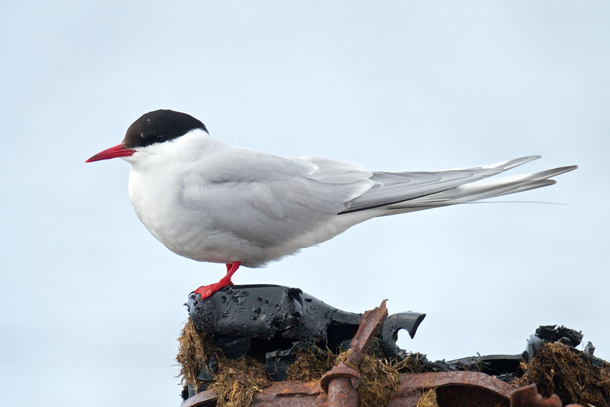
Every year the Arctic Tern follows a migratory pattern of 50,000 miles, one of the longest routes for any bird. (Photo: Gregg Thompson)
[BIRDNOTE THEME]
CURWOOD: From the River of Grass we take you now to a river of birds with BirdNote’s Mary McCann.
[Sounds of migrating birds]
MCCANN: Imagine yourself in the stratosphere, looking down on North America. In spring and fall, you’ll see what look like huge “rivers” of ducks, seabirds, shorebirds, raptors, and songbirds. Migrants are moving along the four major North American flyways. In the spring, these “rivers” of birds flow north. At the end of the breeding season, the “rivers” flow south.
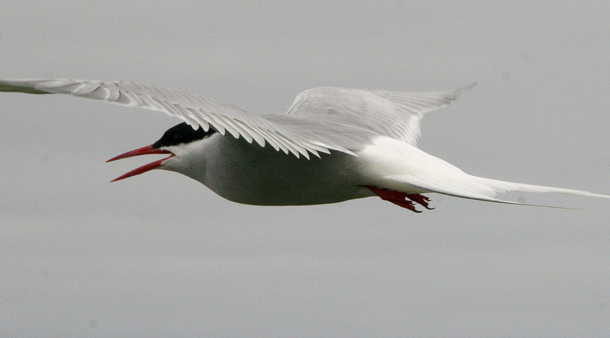
The Arctic Tern has the ability to spend most of its migration gliding rather than flapping its wings. (Photo: Joseph Slocum)
After spending the winter in the southern tier of states or Central America—or even as far away as South America—millions of birds return each spring to the northern latitudes. One of the world champions of long-distance migration is the Arctic Tern. [Calls of Arctic Terns]
Arctic Terns nest across the far northern reaches of the continent during our summer, then fly south to Antarctica for the rest of the year. Some will circle the polar ice-pack before heading north again, completing a total round trip of up to 50,000 miles. Every year. [Calls of Arctic Terns over the sound of ocean waves]
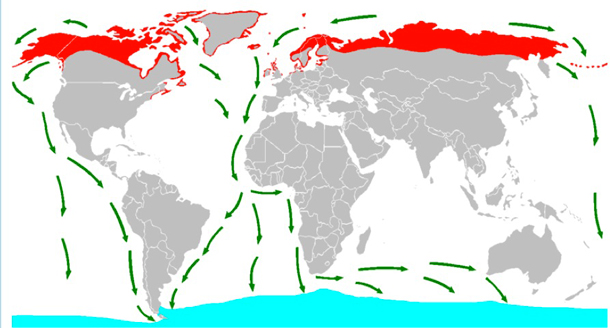
A map of the circumpolar migration that Arctic terns take. (Photo: Andreas Trepete))
###
Adapted from a script written by Frances Wood
Sounds of the migrating geese provided by Martyn Stewart at Naturesound.org.
Call of the Arctic Tern used with permission from Kevin Colver from the Field Guide to Bird Songs, Western Region.
BirdNote's theme music was composed and played by Nancy Rumbel and produced by John Kessler.
Producer: John Kessler
Executive Producer: Chris Peterson
© 2019 Tune In to Nature.org March 2019 Narrator: Mary McCann
CURWOOD: For pictures, swim on over to our website at loe.org.
Related links:
- BirdNote® | "The Arctic Tern is a super star of migration!"
- Audobon | "Guide to North American Birds: Arctic Tern"
[MUSIC: Afro Cuban All Stars, “Habana Del Este” on A Toda Cuba Le Gusta, World Circuit]
CURWOOD: Living on Earth is produced by the World Media Foundation.
Our crew includes Naomi Arenberg, Bobby Bascomb, Delilah Bethel, Paloma Beltran, Thurston Briscoe, Jenni Doering, Don Lyman, Lizz Malloy, Aynsley O’Neill, Jake Rego, Adelaide Chen, and Jolanda Omari. Tom Tiger engineered our show. Alison Lirish Dean composed our themes. Our Executive Producer is Steve Curwood. You can hear us anytime at L-O-E dot org, iTunes and Google play- and like us, please, on our Facebook page - PRI’s Living on Earth. We tweet from @livingonearth. And find us on Instagram at livingonearthradio. I’m Steve Curwood. Thanks for listening!
ANNOUNCER: Funding for Living on Earth comes from you, our listeners, and from the University of Massachusetts, Boston, in association with its School for the Environment, developing the next generation of environmental leaders. And from the Grantham Foundation for the protection of the environment, supporting strategic communications and collaboration in solving the world’s most pressing environmental problems. Support also comes from the Energy Foundation, serving the public interest by helping to build a strong, clean, energy economy and from Carl and Judy Ferenbach of Boston, Massachusetts.
ANNOUNCER 2: PRI, Public Radio International.
Living on Earth wants to hear from you!
Living on Earth
62 Calef Highway, Suite 212
Lee, NH 03861
Telephone: 617-287-4121
E-mail: comments@loe.org
Newsletter [Click here]
Donate to Living on Earth!
Living on Earth is an independent media program and relies entirely on contributions from listeners and institutions supporting public service. Please donate now to preserve an independent environmental voice.
NewsletterLiving on Earth offers a weekly delivery of the show's rundown to your mailbox. Sign up for our newsletter today!
 Sailors For The Sea: Be the change you want to sea.
Sailors For The Sea: Be the change you want to sea.
 The Grantham Foundation for the Protection of the Environment: Committed to protecting and improving the health of the global environment.
The Grantham Foundation for the Protection of the Environment: Committed to protecting and improving the health of the global environment.
 Contribute to Living on Earth and receive, as our gift to you, an archival print of one of Mark Seth Lender's extraordinary wildlife photographs. Follow the link to see Mark's current collection of photographs.
Contribute to Living on Earth and receive, as our gift to you, an archival print of one of Mark Seth Lender's extraordinary wildlife photographs. Follow the link to see Mark's current collection of photographs.
 Buy a signed copy of Mark Seth Lender's book Smeagull the Seagull & support Living on Earth
Buy a signed copy of Mark Seth Lender's book Smeagull the Seagull & support Living on Earth

